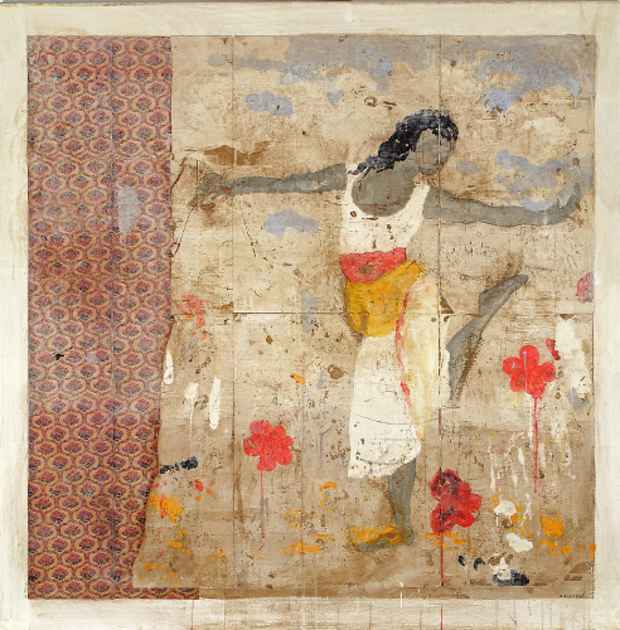Pierre Marie Brisson "A Touch of Mystery"
Franklin Bowles Galleries -New York

This event has ended.
"The museums are here to teach the history of art and something more as well, for, if they stimulate in the weak the desire to imitate, they furnish the strong the means of their emancipation." ~Edgar Degas
For his third show at the Musée Faure in Aix-les-Bains in 2010, a repository of one of the best collections of 19th & 20th century art in France, Pierre Marie Brisson found, as Degas suggested, the means for his emancipation. What he discovered there, especially in Degas' ballerinas, was a new point of departure, and a new way to invent his own paintings. In a recent conversation with Brisson, he reflected on how he was inspired by Degas: "When one is not afraid to love other artist's work and be influenced by what one loves, one feels reassured because of that love and then when one transcribes that influence into one's own language, one truly has something to say."
Brisson was stimulated not only by Degas' works but also by his way of working; Degas was inspired not just by his personal experience of the ballet performances and dance classes he attended, but also by the extensive research he did on the ballet and the depiction of movement. Degas compiled a large collection of photographs on the subjects of dance and movement, which Brisson has done as well.
Degas, who once confided that painting dancers was just a pretext for, "painting pretty fabrics and rendering movement," revealed the everyday gestures of the dancers in repose, their attitudes on stage as well as the detail and beauty of their costumes. Brisson's love of gesture, pattern, and texture reveals his similar mindset. Degas also commented that: "The secret is to follow the advice the masters give you in their works while doing something different from them." Pierre Marie took both the inspiration and the advice from Degas as seen in many of his newest works; but the inspiration has been filtered by Brisson's creativity and transformed into his own very personal and poetic vision.
Every great artist must have a unique voice, different from everyone else's and Pierre Marie Brisson is no exception. The originality of that voice comes essentially from three different characteristics: First, his unique way of connecting us with a distant past and making us experience that past in a very sensorial way in the present. The narrator in Proust's Remembrance of Things Past experienced long-forgotten memories of his childhood evoked by the dipping of a Madeleine in his cup of tea. In a similar way, Brisson uses a series of artistic techniques of his own invention to create the patina of time that connects us physically with the rich textures of his works and through them suggests memories of that which has gone before.
The second characteristic of Brisson's voice is his unique depiction of space. Comparing his flower paintings to traditional still lives, (a recurrent theme of art), a striking difference emerges; unlike typical paintings of flowers which are in some sort of container on a table, or on a tangible surface, Brissonian flowers exist in a poetic space, they float, gravity has disappeared, and there is none of the traditional "grounding." They bring to mind Degas' suggestion that "a painting requires a little mystery, some vagueness, and some fantasy." To create this vagueness and mystery, Brisson has worked many of his latest paintings quite differently. His new touch is very soft, very pastel, lightly veiled. He describes it as "seeing the canvas through lace." This effect also reinforces the poetic quality of that Brissonian suggestion of space.
The third characteristic of Brisson's unique voice is a very rich, personal, and evocative use of color. When I first met Pierre Marie Brisson some 25 years ago, he lived near the Cathedral of Chartres. This sublime example of gothic architecture is visited by countless artists who want to experience and learn from the amazing colors of its medieval stained-glass windows. Experiencing them will change forever your appreciation of and "visceral" connection to color. Like Vincent Van Gogh before him, when Brisson moved south he discovered the colors of the Camargue. The rich yellows of the fields of sunflowers, the blue of the sky reflected in the waters of the delta of the Rhône, the pink flamingos, the reds of the ever present bullrings, the constantly changing colors of the salt marshes where the fleur de sel dries, and the rich ocher of the soil of his vineyards, all would find their way onto his palette. The colors of the Camargue are made even richer by the beauty and intensity of the light which is reflected in the ever-present waters of this French version of the Everglades.
The personal way of linking the present to the past, the poetic depiction of space and the evocative use of colors are the characteristics that give Brisson's voice such a special touch. All these qualities are present in the paintings featured in this exhibition. The dancers -- graceful, feminine, eternal; the poetic and mysterious Brissonian flowers; and a series of portraits, inspired by people in his life especially his daughter, but which reflect a universal quality. Asked what he wished to impart to those who come to see his work, Brisson said, "More than ever today one must teach people how to develop their inquisitiveness. In order to do that it is more interesting to leave the door ajar then wide open. If everything is said, the magic disappears."
Dr. Jean Audigier
Dept. of Art & Architecture
University of San Francisco
Media
Schedule
from June 09, 2012 to July 09, 2012
Opening Reception on 2012-06-09 from 18:00 to 20:00